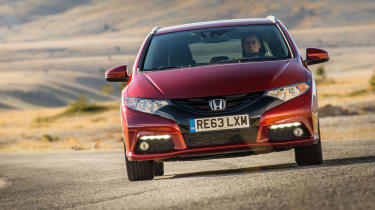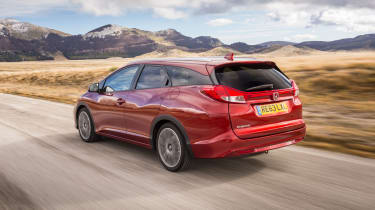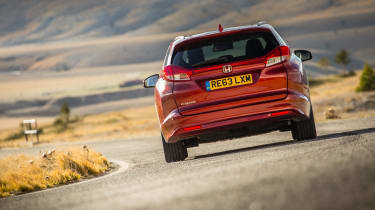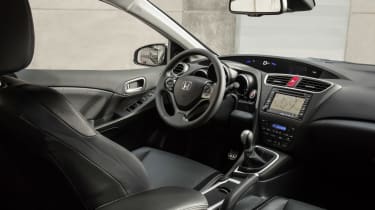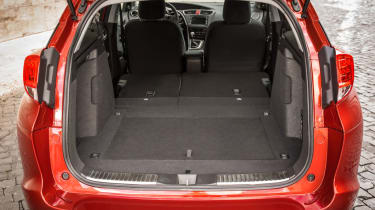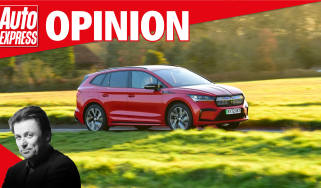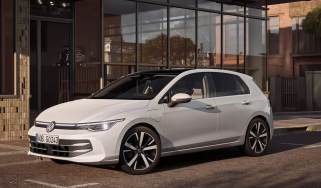Honda Civic Tourer (2014-2017) review
The Honda Civic Tourer is a hugely practical estate, with low CO2 emissions, a comfortable ride and class-leading boot space

The previous generation Honda Civic was only available as a hatchback. However, shortly after the current model went on sale in 2011, the Japanese brand unveiled a more practical estate model with best-in-class boot space and impressive interior practicality.
Honda had to heavily reengineer its five-door Civic hatch in order to offer more space than you’ll find in a Ford Mondeo or Vauxhall Insignia, but the results are well-rounded and nicely executed. The car’s overall length has been increased by 235mm, while the rear of the car has been totally redesigned to make it more practical.
The Civic Tourer’s 624-litre boot has since been surpassed by the latest Peugeot 308 SW, but it remains a versatile and family-friendly estate car. The Civic range was given a light facelift in 2015, with changes to the headlights, grille and bumpers. There’s also a new Android infotainment system as well as new door trims, seat fabrics and dashboard panels.
There are just two engines to choose from in the Civic Tourer, with buyers missing out on the entry-level 1.4-litre petrol from the hatchback range. However, the more powerful 1.8-litre petrol and punchy 1.6-litre diesel suit the car much better and do a good job of hauling the extra weight.
More reviews
Car group tests
- Mercedes-AMG A45 S vs Honda Civic Type R: 2023 twin test review
- Toyota Corolla vs Honda Civic vs Kia Ceed: 2023 group test review
- Honda Civic Type R vs Volkswagen Golf R 20 Years: 2023 twin test review
- The best long-term car tests 2022
- Honda Civic vs Toyota Corolla vs Vauxhall Astra: 2022 group test review
In-depth reviews
Long-term tests
Road tests
All cars come relatively well equipped, but top-spec models also benefit from a new adaptive rear damping system that makes the Civic Tourer more comfortable and adjusts the handling when carrying heavy loads in the back. A ‘Navi’ pack is available on some trims, and is well worth £610 premium.
The entry-level trim is called the S, and features 16-inch alloys, climate control, automatic brake assist and Bluetooth/DAB radio with steering wheel controls. SE Plus trim adds 17-inch alloys, parking sensors and Honda Connect in-car audio with a 7-inch touchscreen and reversing camera. The SR adds heated leather seats, active dampers and a stereo upgrade, while the top spec EX Plus has keyless entry and all the bells and whistles.
The Honda Civic Tourer was launched to wide acclaim for its practical interior accommodation that offered more load space than popular rivals in the class above. Five years on, it’s still highly competitive on any measure as a load-lugger.
The styling of the Civic hatch has been divisive in recent years, and that has affected the Tourer model too – it's a car you’re either going to like looking at, or you’re not.
Engine choices are limited, but while the petrol is a pretty unsatisfactory option the diesel is a cracker. It’s smooth, punchy and extremely efficient.
Prices are a little on the high side, a fact that isn’t helped by the Civic Tourer’s less than class-leading depreciation. At least spec levels are high though, and reliability should be excellent.
Engines, performance and drive
While the accommodation may be exceptionally good for family road trips, unfortunately the chassis set-up of the Civic Tourer is a bit of a letdown. It stays relatively comfortable when cruising, and has a softer edge than its rivals. But it’s still unsettled by bumps, and soft suspension means there’s significant body roll in corners.
The steering responds quickly, but it’s light and provides very little in the way of feedback. Push on, and soon the Honda will understeer, while the inside front wheel has a tendency to spin up if you accelerate with even a modest amount of steering lock applied.
In town, the Civic is relatively smooth, but the stop-start system is surprisingly rough. Every time the engine cut out or restarted, it sent a noticeable shudder through the cabin.
Engines
The 1.6-litre i-DTEC diesel engine is definitely the highlight of the Civic engine range. It’s a real gem, as it’s smoother and punchier than the 1.6-litre TDI found in the SEAT Leon ST and Skoda Octavia Estate. A six-speed manual gearbox makes the most of its performance thanks to a clean, precise shift action.
• Honda Civic Tourer diesel review
The petrol option is a 1.8-litre i-VTEC unit that revs freely, but feels a lot slower than its diesel counterpart. It does come with a choice of either manual or automatic gearbox but has to be worked hard to match the same easy in-gear grunt of the diesel, which spoils refinement. It struggles up steep hills too, and would not cope well once it has been fully loaded up with passengers and luggage. The petrol doesn’t look too bad on the figures alone, with a 0-62mph time of 9.2 seconds and a 130mph top speed. It’s simply that the engine’s revvy nature doesn’t suit an estate car used in the way its designers intended.
Indeed the diesel’s 0-62mph time is slower at 10.3 seconds, but the power and torque delivery makes the engine seem much more flexible.
MPG, CO2 and Running Costs
The Honda Civic Tourer comes well equipped, with all models getting Bluetooth, digital DAB radio and 16-inch alloy wheels.
You can add a ‘Navi’ package to most trim levels for around £610, but you have to move up to higher-spec SE or SR trims to get goodies such as leather or xenon lights. The list price means the Honda will be a fairly expensive company car choice, too.
Go for the diesel and you’ll get a car with a range of over 800 miles that returns an official economy figure of 74.3mpg and emits just 99g/km of CO2 – which makes it road tax exempt and should keep running costs very low indeed. Higher-spec models with bigger wheels suffer slightly – with the range-topping EX Plus posting figures of 72.4mpg and 103g/km.
The petrol is less impressive, with a combined 45.6mpg and CO2 emissions of 146g/km - not bad but roughly the same as a four-wheel drive TDI version of the new Skoda Octavia.
Honda is famed for its mechanical reliability but does not offer the same long warranties as some of its mainstream rivals like Hyundai and Toyota. Depreciation will also be slightly higher than cars like the VW Golf Estate, even with the small fuel bills.
Insurance groups
Insurance bands are pretty tightly stacked for the Civic Tourer, which isn't a surprise as it has only two engines with similar performance. Group ratings are 13 to 16.
Depreciation
Depreciation isn’t desperately bad for the Civic Tourer, as long as you pick the right model. Used car valuation experts CAP reckon the 1.6 diesel variant in S or S Navi trim should retain 43 per cent of its new price after three years and 30,000 miles. It gets worse if you pick the wrong model of course, which in this case means a high-spec petrol variant such as the 1.8 VTEC EX Plus. CAP predicts a residual value of just 36 per cent for that one, but they don’t expect any of the petrols to attain 40 per cent.
Interior, design and technology
Opinion has been divided over the latest Honda Civic hatchback’s styling, and the Tourer is likely to provoke a similar reaction. It’s 235mm longer than the five-door hatch, with all the extra length at the back of the car.
Up front, you get the same short, rising bonnet, large wheelarches and distinctive nose as the hatch, while the A-pillars arc into the roof, which has been enhanced by flush silver rails. The roof flows elegantly into the tailgate, and the window line tapers down towards the tail lamps. Those large light clusters wrap around the back of the car and are joined by a red bar, while a relatively small rear screen and spoiler finish it off.
All models underwent a mid-life facelift in 2015, with changes to the headlights, grille and bumpers. Inside, changes have been made to the seat fabrics, door trims and dash panels. While none of it is particularly revolutionary, it gives the Japanese estate car fresh appeal.
That said, we still think the Civic Tourer looks rather fussy, and the large gaps around the tailgate are at odds with the tight shut lines you’ll find on the SEAT Leon ST.
Elsewhere, the Tourer’s cabin is identical to the hatchback’s. So the two-level dash is carried over, complete with the digital speedometer and multifunction display on top, plus a central rev counter ahead of you.
The driving position is high, in contrast to the low steering wheel, but the split in the dash means you can read the dials without the wheel getting in the way. On the centre console, there’s an array of buttons for the various functions. These take some getting used to, but are easy to use on the move.
Sat-nav, stereo and infotainment
The touchscreen-equipped versions of the Civic Tourer feature Honda Connect, which includes Garmin navigation with real time traffic info. You also get full phone functionality via the touchscreen, with Bluetooth, WiFi, USB and HDMI connections for internet and music streaming. The entry level S model gets a four speaker stereo with Bluetooth, while Honda Connect system has eight speakers.
Practicality, comfort and boot space
Honda is proud of the so-called ‘magic seats’ in the Civic Tourer. They are pretty unique as the rear seat squabs fold upwards to create a load space in the middle of the car – as well as folding flat in the normal fashion to create a cavernous load space. You can only operate the back seats from the passenger compartment, but they fold in one swift action.
Up front the only real irritation is the awkwardly high driving position, which makes it hard to get comfortable at the wheel. Another slight issue though is the seat adjustment, which is done with a stepped lever rather than a wheel. This forces you to either sit too upright or too reclined, without any middle ground. Still, storage is decent, with a deep armrest bin and sunglasses holder, a big glovebox and reasonably sized door bins, although they’re smaller than those in the Skoda Octavia Estate.
Size
The Civic Tourer is 4,590mm long, 1,770mm wide and 1,480mm tall. This compares to 4,560mm x 1,823mm x 1,492mm for the Ford Focus estate and 4,659mm x 1,814mm x 1,465mm for the Skoda Octavia estate.
Leg room, head room & passenger space
Return the Magic Seats to a seating position, and the Honda has less room for passengers than rivals, while the angled door pillars make it feel more enclosed.
However the longer roof of the Tourer means rear headroom is better than on the hatchback.
Boot
The Civic Tourer used to boast the biggest boot in its class. However, since the introduction of the capacious Peugeot 308 SW, the 624-litre boot has now been surpassed. It’s still a practical car though, with the square opening and load lip revealing a useable 1,668 litres with the rear seats folded flat.
There are four lashing eyes in the boot floor, and a deep bin underneath. Yet while the Honda has a 12V power socket, there are no bag hooks, the load cover is fiddly to use – although it can be stored under the boot floor when it’s not needed.
Reliability and Safety
If you want peace of mind, then the Civic will deliver rock-solid reliability. Like most Japanese manufacturers, Honda has a good reputation for building cars that last, and the Tourer should be no exception. It’s built at Honda’s UK factory in Swindon, Wiltshire, so you’ll be able to fly the flag for British manufacturing with pride, too.
Indeed, checking the 2015 Driver Power satisfaction survey reveals the Civic scoring a ranking of 41st overall out of 200 cars. That strong result included individual rankings of 45th out of 200 for reliability and 62nd for build quality.
Honda’s dealers also performed well in our Driver Power satisfaction survey. They finished in fourth place, three positions ahead of Skoda, so it seems reasonable to expect first-class customer service if anything does go wrong.
The Civic hatchback has a five-star Euro NCAP crash-test rating, although it only has six airbags compared to rivals’ seven. Honda’s Driver Assistance Safety Pack, which adds city braking, lane departure warning, traffic sign recognition, a blind-spot monitor and more, is only available as a optional extra on SE models and above.
The category ratings from Euro NCAP were 94 per cent for adult occupant safety, 83 per cent for child occupant safety, 69 per cent for pedestrian safety and 86 per cent for safety assistance systems – so decent scores across the board.
The Ford Focus scored 92, 82, 72 and 71 per cent in the same categories, while the Skoda Octavia managed 93, 86, 66 and 66 per cent.
Warranty
Honda offers a three-year warranty package, but the mileage cap is higher than some rivals at 90,000 miles. The company also offers extended warranties at extra cost.
Servicing
Honda’s servicing isn’t particularly expensive, and the brand has fixed prices so you can budget accordingly. Service intervals are every 12,500 miles or annual, and year one, two and three services cost £195, £265 and £245 for the petrol model, or £215, £285 and £265 for the diesel.
